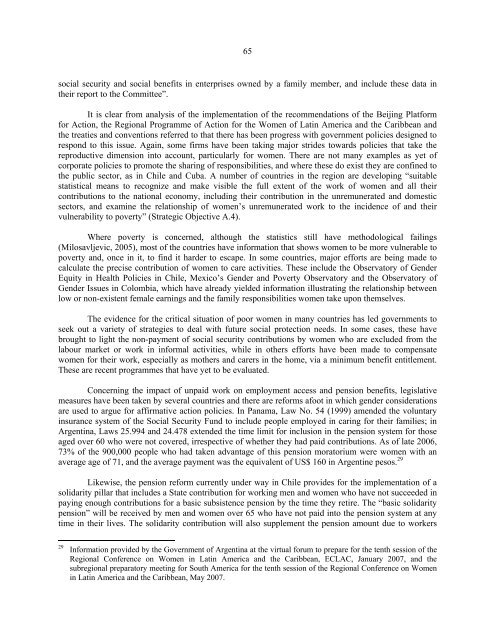Women in Latin America and the Caribbean - Cepal
Women in Latin America and the Caribbean - Cepal
Women in Latin America and the Caribbean - Cepal
You also want an ePaper? Increase the reach of your titles
YUMPU automatically turns print PDFs into web optimized ePapers that Google loves.
65<br />
social security <strong>and</strong> social benefits <strong>in</strong> enterprises owned by a family member, <strong>and</strong> <strong>in</strong>clude <strong>the</strong>se data <strong>in</strong><br />
<strong>the</strong>ir report to <strong>the</strong> Committee”.<br />
It is clear from analysis of <strong>the</strong> implementation of <strong>the</strong> recommendations of <strong>the</strong> Beij<strong>in</strong>g Platform<br />
for Action, <strong>the</strong> Regional Programme of Action for <strong>the</strong> <strong>Women</strong> of Lat<strong>in</strong> <strong>America</strong> <strong>and</strong> <strong>the</strong> <strong>Caribbean</strong> <strong>and</strong><br />
<strong>the</strong> treaties <strong>and</strong> conventions referred to that <strong>the</strong>re has been progress with government policies designed to<br />
respond to this issue. Aga<strong>in</strong>, some firms have been tak<strong>in</strong>g major strides towards policies that take <strong>the</strong><br />
reproductive dimension <strong>in</strong>to account, particularly for women. There are not many examples as yet of<br />
corporate policies to promote <strong>the</strong> shar<strong>in</strong>g of responsibilities, <strong>and</strong> where <strong>the</strong>se do exist <strong>the</strong>y are conf<strong>in</strong>ed to<br />
<strong>the</strong> public sector, as <strong>in</strong> Chile <strong>and</strong> Cuba. A number of countries <strong>in</strong> <strong>the</strong> region are develop<strong>in</strong>g “suitable<br />
statistical means to recognize <strong>and</strong> make visible <strong>the</strong> full extent of <strong>the</strong> work of women <strong>and</strong> all <strong>the</strong>ir<br />
contributions to <strong>the</strong> national economy, <strong>in</strong>clud<strong>in</strong>g <strong>the</strong>ir contribution <strong>in</strong> <strong>the</strong> unremunerated <strong>and</strong> domestic<br />
sectors, <strong>and</strong> exam<strong>in</strong>e <strong>the</strong> relationship of women’s unremunerated work to <strong>the</strong> <strong>in</strong>cidence of <strong>and</strong> <strong>the</strong>ir<br />
vulnerability to poverty” (Strategic Objective A.4).<br />
Where poverty is concerned, although <strong>the</strong> statistics still have methodological fail<strong>in</strong>gs<br />
(Milosavljevic, 2005), most of <strong>the</strong> countries have <strong>in</strong>formation that shows women to be more vulnerable to<br />
poverty <strong>and</strong>, once <strong>in</strong> it, to f<strong>in</strong>d it harder to escape. In some countries, major efforts are be<strong>in</strong>g made to<br />
calculate <strong>the</strong> precise contribution of women to care activities. These <strong>in</strong>clude <strong>the</strong> Observatory of Gender<br />
Equity <strong>in</strong> Health Policies <strong>in</strong> Chile, Mexico’s Gender <strong>and</strong> Poverty Observatory <strong>and</strong> <strong>the</strong> Observatory of<br />
Gender Issues <strong>in</strong> Colombia, which have already yielded <strong>in</strong>formation illustrat<strong>in</strong>g <strong>the</strong> relationship between<br />
low or non-existent female earn<strong>in</strong>gs <strong>and</strong> <strong>the</strong> family responsibilities women take upon <strong>the</strong>mselves.<br />
The evidence for <strong>the</strong> critical situation of poor women <strong>in</strong> many countries has led governments to<br />
seek out a variety of strategies to deal with future social protection needs. In some cases, <strong>the</strong>se have<br />
brought to light <strong>the</strong> non-payment of social security contributions by women who are excluded from <strong>the</strong><br />
labour market or work <strong>in</strong> <strong>in</strong>formal activities, while <strong>in</strong> o<strong>the</strong>rs efforts have been made to compensate<br />
women for <strong>the</strong>ir work, especially as mo<strong>the</strong>rs <strong>and</strong> carers <strong>in</strong> <strong>the</strong> home, via a m<strong>in</strong>imum benefit entitlement.<br />
These are recent programmes that have yet to be evaluated.<br />
Concern<strong>in</strong>g <strong>the</strong> impact of unpaid work on employment access <strong>and</strong> pension benefits, legislative<br />
measures have been taken by several countries <strong>and</strong> <strong>the</strong>re are reforms afoot <strong>in</strong> which gender considerations<br />
are used to argue for affirmative action policies. In Panama, Law No. 54 (1999) amended <strong>the</strong> voluntary<br />
<strong>in</strong>surance system of <strong>the</strong> Social Security Fund to <strong>in</strong>clude people employed <strong>in</strong> car<strong>in</strong>g for <strong>the</strong>ir families; <strong>in</strong><br />
Argent<strong>in</strong>a, Laws 25.994 <strong>and</strong> 24.478 extended <strong>the</strong> time limit for <strong>in</strong>clusion <strong>in</strong> <strong>the</strong> pension system for those<br />
aged over 60 who were not covered, irrespective of whe<strong>the</strong>r <strong>the</strong>y had paid contributions. As of late 2006,<br />
73% of <strong>the</strong> 900,000 people who had taken advantage of this pension moratorium were women with an<br />
average age of 71, <strong>and</strong> <strong>the</strong> average payment was <strong>the</strong> equivalent of US$ 160 <strong>in</strong> Argent<strong>in</strong>e pesos. 29<br />
Likewise, <strong>the</strong> pension reform currently under way <strong>in</strong> Chile provides for <strong>the</strong> implementation of a<br />
solidarity pillar that <strong>in</strong>cludes a State contribution for work<strong>in</strong>g men <strong>and</strong> women who have not succeeded <strong>in</strong><br />
pay<strong>in</strong>g enough contributions for a basic subsistence pension by <strong>the</strong> time <strong>the</strong>y retire. The “basic solidarity<br />
pension” will be received by men <strong>and</strong> women over 65 who have not paid <strong>in</strong>to <strong>the</strong> pension system at any<br />
time <strong>in</strong> <strong>the</strong>ir lives. The solidarity contribution will also supplement <strong>the</strong> pension amount due to workers<br />
29<br />
Information provided by <strong>the</strong> Government of Argent<strong>in</strong>a at <strong>the</strong> virtual forum to prepare for <strong>the</strong> tenth session of <strong>the</strong><br />
Regional Conference on <strong>Women</strong> <strong>in</strong> Lat<strong>in</strong> <strong>America</strong> <strong>and</strong> <strong>the</strong> <strong>Caribbean</strong>, ECLAC, January 2007, <strong>and</strong> <strong>the</strong><br />
subregional preparatory meet<strong>in</strong>g for South <strong>America</strong> for <strong>the</strong> tenth session of <strong>the</strong> Regional Conference on <strong>Women</strong><br />
<strong>in</strong> Lat<strong>in</strong> <strong>America</strong> <strong>and</strong> <strong>the</strong> <strong>Caribbean</strong>, May 2007.











